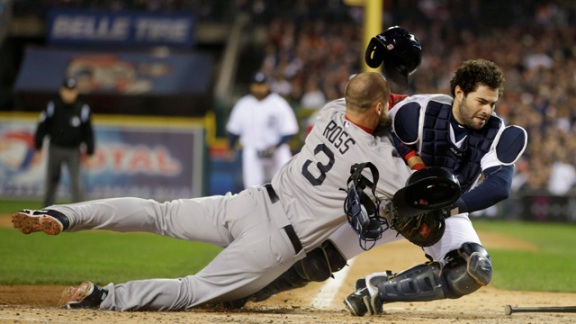Major League Baseball issued an illustrated memorandum to all teams Tuesday in an attempt to clear up any potential confusion about the rules governing collisions at home plate.The key point, according to managers who saw the letter, is that common sense must prevail. Specifically, even though catchers are required by the letter of Rule 7.13 to allow a part of the plate to slide to, a runner who is clearly beaten by the throw should not be called safe on a technicality.  ESPN.com reported that the letter instructs umpires not to call a runner safe if there is no evidence that the catcher has "hindered or impeded" the runner's path to the plate."I think it's pretty much the same thing," said Atlanta's Fredi Gonzalez. "I read it twice. [Bench coach] Carlos Tosca read it twice. And what we came up with is that it's basically the same thing, but that the [replay] officials in New York are going to use ... common sense. If you're out by 40 feet and the catcher just happened to be [blocking] the plate, come on, guys, let's not call that guy safe because of that. That's the way I understood it."Affirmed Tampa Bay's Joe Maddon: "I think the biggest thing is even blocking the plate and the runner's so far away from him and you can see that the runner is clearly going to be out, that you can't alter the call because of the fact that he was in his way. That would be the biggest thing."Managers were also reminded to use good judgment when deciding whether to challenge calls at the plate based on 7.13.The intent behind new regulations implemented this year was clear: To safeguard both catchers and runners from injuries that can result from violent collisions at the plate. To that end, catchers were not allowed to block the plate without the ball and runners were not allowed to deviate from their path for the sole intent of jarring the ball loose.The split-second, real world interpretation wasn't always as obvious, though. Which is why, with the stretch drive underway and the postseason approaching, MLB and the Major League Baseball Players Association negotiated the guidelines that were distributed.The rule has been successful on many levels."I think overall the rule has been good. We've had nobody injured, which I think is the baseline for that rule," said Nationals manager Matt Williams.There have a relative few number of plays, however, that raised questions and created some concern about a playoff game being decided by a disputed call at the plate, which led to Tuesday's clarification. The incident most often-referenced occurred in a July 31 game between the Marlins and Reds when Miami right fielder Giancarlo Stanton gunned down what would have been the tying run at the plate to end the eighth inning. However, the call was reversed when replay officials decided that catcher Jeff Mathis had been blocking the plate and the Reds went on to win the game."There here were a handful of plays, five or six, where they were interpreting the rule way too strictly," Gonzalez said. "The Cincinnati-Miami game comes to mind. That was the memo we got today. It was more of a reminder."Said Angels manager Mike Scioscia, who is a former big league catcher: "I think it definitely gave us some clarity. There's probably more of a comfort level of what a replay official would see and call. That's probably the source of the most controversy. I think the guidelines are very clear now. If the catcher's positioning in that lane is not impacting the play, then it's a non-call. That makes sense."It's really just the spirit of the play. When the ball beats the runner by that much, he should be out, no matter what the catcher does. If the runner has the play beat, he should be safe no matter what the catcher does. Hopefully it's going to be interpreted the way it should be. There is more depth in the explanation of it."It's been a work in progress. One thing's for sure. It has eliminated the collisions at home plate, and that's a good thing. But in the balance of what right does a catcher have, what right does the runner have, there's more clarity now."It was never thought that Tuesday's letter would alleviate every concern, and it didn't. "It's still a work in progress, like everything else," Williams said. "We've got some questions we want to ask and discussions we want to have. But we'll get through it. We'll continue to look at it and continue to talk about it."It's considered likely that further tweaks will be made this offseason to a rule that was labeled "experimental" when it was announced this spring.Paul Hagen / MLB.com
ESPN.com reported that the letter instructs umpires not to call a runner safe if there is no evidence that the catcher has "hindered or impeded" the runner's path to the plate."I think it's pretty much the same thing," said Atlanta's Fredi Gonzalez. "I read it twice. [Bench coach] Carlos Tosca read it twice. And what we came up with is that it's basically the same thing, but that the [replay] officials in New York are going to use ... common sense. If you're out by 40 feet and the catcher just happened to be [blocking] the plate, come on, guys, let's not call that guy safe because of that. That's the way I understood it."Affirmed Tampa Bay's Joe Maddon: "I think the biggest thing is even blocking the plate and the runner's so far away from him and you can see that the runner is clearly going to be out, that you can't alter the call because of the fact that he was in his way. That would be the biggest thing."Managers were also reminded to use good judgment when deciding whether to challenge calls at the plate based on 7.13.The intent behind new regulations implemented this year was clear: To safeguard both catchers and runners from injuries that can result from violent collisions at the plate. To that end, catchers were not allowed to block the plate without the ball and runners were not allowed to deviate from their path for the sole intent of jarring the ball loose.The split-second, real world interpretation wasn't always as obvious, though. Which is why, with the stretch drive underway and the postseason approaching, MLB and the Major League Baseball Players Association negotiated the guidelines that were distributed.The rule has been successful on many levels."I think overall the rule has been good. We've had nobody injured, which I think is the baseline for that rule," said Nationals manager Matt Williams.There have a relative few number of plays, however, that raised questions and created some concern about a playoff game being decided by a disputed call at the plate, which led to Tuesday's clarification. The incident most often-referenced occurred in a July 31 game between the Marlins and Reds when Miami right fielder Giancarlo Stanton gunned down what would have been the tying run at the plate to end the eighth inning. However, the call was reversed when replay officials decided that catcher Jeff Mathis had been blocking the plate and the Reds went on to win the game."There here were a handful of plays, five or six, where they were interpreting the rule way too strictly," Gonzalez said. "The Cincinnati-Miami game comes to mind. That was the memo we got today. It was more of a reminder."Said Angels manager Mike Scioscia, who is a former big league catcher: "I think it definitely gave us some clarity. There's probably more of a comfort level of what a replay official would see and call. That's probably the source of the most controversy. I think the guidelines are very clear now. If the catcher's positioning in that lane is not impacting the play, then it's a non-call. That makes sense."It's really just the spirit of the play. When the ball beats the runner by that much, he should be out, no matter what the catcher does. If the runner has the play beat, he should be safe no matter what the catcher does. Hopefully it's going to be interpreted the way it should be. There is more depth in the explanation of it."It's been a work in progress. One thing's for sure. It has eliminated the collisions at home plate, and that's a good thing. But in the balance of what right does a catcher have, what right does the runner have, there's more clarity now."It was never thought that Tuesday's letter would alleviate every concern, and it didn't. "It's still a work in progress, like everything else," Williams said. "We've got some questions we want to ask and discussions we want to have. But we'll get through it. We'll continue to look at it and continue to talk about it."It's considered likely that further tweaks will be made this offseason to a rule that was labeled "experimental" when it was announced this spring.Paul Hagen / MLB.com
 ESPN.com reported that the letter instructs umpires not to call a runner safe if there is no evidence that the catcher has "hindered or impeded" the runner's path to the plate."I think it's pretty much the same thing," said Atlanta's Fredi Gonzalez. "I read it twice. [Bench coach] Carlos Tosca read it twice. And what we came up with is that it's basically the same thing, but that the [replay] officials in New York are going to use ... common sense. If you're out by 40 feet and the catcher just happened to be [blocking] the plate, come on, guys, let's not call that guy safe because of that. That's the way I understood it."Affirmed Tampa Bay's Joe Maddon: "I think the biggest thing is even blocking the plate and the runner's so far away from him and you can see that the runner is clearly going to be out, that you can't alter the call because of the fact that he was in his way. That would be the biggest thing."Managers were also reminded to use good judgment when deciding whether to challenge calls at the plate based on 7.13.The intent behind new regulations implemented this year was clear: To safeguard both catchers and runners from injuries that can result from violent collisions at the plate. To that end, catchers were not allowed to block the plate without the ball and runners were not allowed to deviate from their path for the sole intent of jarring the ball loose.The split-second, real world interpretation wasn't always as obvious, though. Which is why, with the stretch drive underway and the postseason approaching, MLB and the Major League Baseball Players Association negotiated the guidelines that were distributed.The rule has been successful on many levels."I think overall the rule has been good. We've had nobody injured, which I think is the baseline for that rule," said Nationals manager Matt Williams.There have a relative few number of plays, however, that raised questions and created some concern about a playoff game being decided by a disputed call at the plate, which led to Tuesday's clarification. The incident most often-referenced occurred in a July 31 game between the Marlins and Reds when Miami right fielder Giancarlo Stanton gunned down what would have been the tying run at the plate to end the eighth inning. However, the call was reversed when replay officials decided that catcher Jeff Mathis had been blocking the plate and the Reds went on to win the game."There here were a handful of plays, five or six, where they were interpreting the rule way too strictly," Gonzalez said. "The Cincinnati-Miami game comes to mind. That was the memo we got today. It was more of a reminder."Said Angels manager Mike Scioscia, who is a former big league catcher: "I think it definitely gave us some clarity. There's probably more of a comfort level of what a replay official would see and call. That's probably the source of the most controversy. I think the guidelines are very clear now. If the catcher's positioning in that lane is not impacting the play, then it's a non-call. That makes sense."It's really just the spirit of the play. When the ball beats the runner by that much, he should be out, no matter what the catcher does. If the runner has the play beat, he should be safe no matter what the catcher does. Hopefully it's going to be interpreted the way it should be. There is more depth in the explanation of it."It's been a work in progress. One thing's for sure. It has eliminated the collisions at home plate, and that's a good thing. But in the balance of what right does a catcher have, what right does the runner have, there's more clarity now."It was never thought that Tuesday's letter would alleviate every concern, and it didn't. "It's still a work in progress, like everything else," Williams said. "We've got some questions we want to ask and discussions we want to have. But we'll get through it. We'll continue to look at it and continue to talk about it."It's considered likely that further tweaks will be made this offseason to a rule that was labeled "experimental" when it was announced this spring.Paul Hagen / MLB.com
ESPN.com reported that the letter instructs umpires not to call a runner safe if there is no evidence that the catcher has "hindered or impeded" the runner's path to the plate."I think it's pretty much the same thing," said Atlanta's Fredi Gonzalez. "I read it twice. [Bench coach] Carlos Tosca read it twice. And what we came up with is that it's basically the same thing, but that the [replay] officials in New York are going to use ... common sense. If you're out by 40 feet and the catcher just happened to be [blocking] the plate, come on, guys, let's not call that guy safe because of that. That's the way I understood it."Affirmed Tampa Bay's Joe Maddon: "I think the biggest thing is even blocking the plate and the runner's so far away from him and you can see that the runner is clearly going to be out, that you can't alter the call because of the fact that he was in his way. That would be the biggest thing."Managers were also reminded to use good judgment when deciding whether to challenge calls at the plate based on 7.13.The intent behind new regulations implemented this year was clear: To safeguard both catchers and runners from injuries that can result from violent collisions at the plate. To that end, catchers were not allowed to block the plate without the ball and runners were not allowed to deviate from their path for the sole intent of jarring the ball loose.The split-second, real world interpretation wasn't always as obvious, though. Which is why, with the stretch drive underway and the postseason approaching, MLB and the Major League Baseball Players Association negotiated the guidelines that were distributed.The rule has been successful on many levels."I think overall the rule has been good. We've had nobody injured, which I think is the baseline for that rule," said Nationals manager Matt Williams.There have a relative few number of plays, however, that raised questions and created some concern about a playoff game being decided by a disputed call at the plate, which led to Tuesday's clarification. The incident most often-referenced occurred in a July 31 game between the Marlins and Reds when Miami right fielder Giancarlo Stanton gunned down what would have been the tying run at the plate to end the eighth inning. However, the call was reversed when replay officials decided that catcher Jeff Mathis had been blocking the plate and the Reds went on to win the game."There here were a handful of plays, five or six, where they were interpreting the rule way too strictly," Gonzalez said. "The Cincinnati-Miami game comes to mind. That was the memo we got today. It was more of a reminder."Said Angels manager Mike Scioscia, who is a former big league catcher: "I think it definitely gave us some clarity. There's probably more of a comfort level of what a replay official would see and call. That's probably the source of the most controversy. I think the guidelines are very clear now. If the catcher's positioning in that lane is not impacting the play, then it's a non-call. That makes sense."It's really just the spirit of the play. When the ball beats the runner by that much, he should be out, no matter what the catcher does. If the runner has the play beat, he should be safe no matter what the catcher does. Hopefully it's going to be interpreted the way it should be. There is more depth in the explanation of it."It's been a work in progress. One thing's for sure. It has eliminated the collisions at home plate, and that's a good thing. But in the balance of what right does a catcher have, what right does the runner have, there's more clarity now."It was never thought that Tuesday's letter would alleviate every concern, and it didn't. "It's still a work in progress, like everything else," Williams said. "We've got some questions we want to ask and discussions we want to have. But we'll get through it. We'll continue to look at it and continue to talk about it."It's considered likely that further tweaks will be made this offseason to a rule that was labeled "experimental" when it was announced this spring.Paul Hagen / MLB.com


